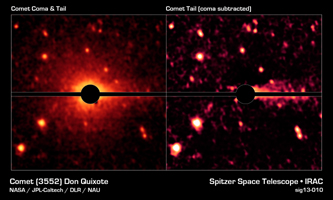
|
Spitzer Spies a Comet Coma and Tail
- Click the image above for a larger view
- Full-Res JPEG (2400 x 2400) (189.8 kB)
- Full-Res TIFF (2400 x 2400) (17.3 MB)
Caption:

Figure 1
Click on the image for larger version
With the help of NASA's Spitzer Space Telescope, astronomers have discovered that what was thought to be a large asteroid called Don Quixote is in fact a comet.
In Figure 1, the left image shows Don Quixote's coma and tail -- features of comets -- as revealed in infrared light by Spitzer. The coma appears as a faint glow around the center of the body, caused by dust and gas. The tail, which appears more clearly in the right image, points towards the right-hand side of Don Quixote, into the direction opposite of the sun. The right image represents a more elaborate image processing step, in which the glow of the coma has been removed based on a model comet coma.Bright speckles around Don Quixote are background stars; the horizontal bar covers image artifacts caused by the image processing.
Background Info:
NASA's Jet Propulsion Laboratory, Pasadena, Calif., manages the Spitzer Space Telescope mission for NASA's Science Mission Directorate, Washington. Science operations are conducted at the Spitzer Science Center at the California Institute of Technology in Pasadena. Data are archived at the Infrared Science Archive housed at the Infrared Processing and Analysis Center at Caltech. Caltech manages JPL for NASA.
For more information about Spitzer, visit http://spitzer.caltech.edu and http://www.nasa.gov/spitzer .
Cataloging Keywords:
| Name | Value | Additional Values |
|---|---|---|
| Target | 3552 Don Quixote | |
| System | Main Belt | |
| Target Type | Asteroid | |
| Mission | Spitzer Space Telescope | |
| Instrument Host | Spitzer Space Telescope | |
| Host Type | Space Telescope | |
| Instrument | Infrared Array Camera (IRAC) | |
| Detector | ||
| Extra Keywords | Color, Dust, Infrared | |
| Acquisition Date | ||
| Release Date | 2013-09-10 | |
| Date in Caption | ||
| Image Credit | NASA/JPL-Caltech/DLR/NAU | |
| Source | photojournal.jpl.nasa.gov/catalog/PIA17443 | |
| Identifier | PIA17443 | |
